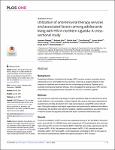| dc.contributor.author | Odongo, Innocent | |
| dc.contributor.author | Arim, Barbara | |
| dc.contributor.author | Ayer, Patrick | |
| dc.contributor.author | Murungi, Tom | |
| dc.contributor.author | Akullo, Susan | |
| dc.contributor.author | Aceng, Docus | |
| dc.contributor.author | Oboke, Henry | |
| dc.contributor.author | Kumakech, Edward | |
| dc.contributor.author | Obua, Celestino | |
| dc.contributor.author | Auma, Anna Grace | |
| dc.contributor.author | Richard, Nyeko | |
| dc.date.accessioned | 2023-07-17T09:06:16Z | |
| dc.date.available | 2023-07-17T09:06:16Z | |
| dc.date.issued | 2023 | |
| dc.identifier.citation | Odongo, I., Arim, B., Ayer, P., Murungi, T., Akullo, S., Aceng, D., Oboke, H., Kumakech, E., Obua, C., Auma,A.M., and NyekoI, R. (2023). Utilization of antiretroviral therapy services and associated factors among adolescents living with HIV in northern Uganda: A cross-sectional study. PLoS ONE 18(7): e0288410. | en_US |
| dc.identifier.uri | https://doi.org/10.1371/ journal.pone.0288410 | |
| dc.identifier.uri | http://ir.lirauni.ac.ug/xmlui/handle/123456789/727 | |
| dc.description.abstract | Background
Suboptimal utilization of antiretroviral therapy (ART) services remains a problem among
adolescents in low- and middle-income countries, which has a negative impact on their
response to treatment and increases the risk of developing resistance. Optimal use is
essential to enhancing treatment efficacy. We investigated the optimal use of ART service
and predictors among adolescents living with HIV (ALHIV) in northern Uganda.
Methods
We used a cross-sectional study design to collect quantitative data from 293 ALHIV at three
health facilities in Lira municipality, northern Uganda. We used an interviewer-administered
questionnaire and data abstraction form. Data were analysed using SPSS version 23 soft ware. Descriptive analysis and logistic regressions were performed to determine the relation ship between the predictor and outcome variables. Statistical significance was determined at
P-value<0.05 and the adjusted odds ratio with a 95% confidence interval was used.
Results
The level of utilization of ART services was suboptimal among 27.6% (81/293) of the partici pants, and only 63.1% (185/293) were virally suppressed. Of the participants who were opti mally utilizing ART services, the majority 86.8% (184/212) were virally suppressed. Age 10–
14 years (aOR = 3.34), the presence of both parents (aOR = 1.85), parental and peer
reminders (aOR = 2.91) and (aOR = 0.49) respectively, and being on ART for five years or
less were the characteristics related with optimal utilization of ART services. Conclusions and recommendations
Not all ALHIV used ART services to their full potential. However, factors such as partici pants’ age, the presence of both parents, reminders from parents and peers, and being on
ART for some time were all related to the optimal use of ART services. There is a need for
developing strategies to increase family and peer support with a focus on older adolescents
if the 95-95-95 goal is to be achieved in this age group. | en_US |
| dc.language.iso | en | en_US |
| dc.publisher | PLoS ONE | en_US |
| dc.subject | Utilization | en_US |
| dc.subject | Antiretroviral therapy services | en_US |
| dc.subject | Adolescents living with HIV | en_US |
| dc.subject | Northern Uganda | en_US |
| dc.title | Utilization of antiretroviral therapy services and associated factors among adolescents living with HIV in northern Uganda: A cross-sectional study | en_US |
| dc.type | Article | en_US |

